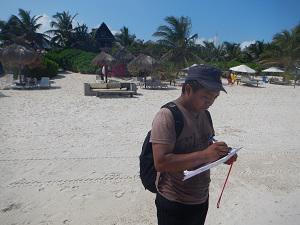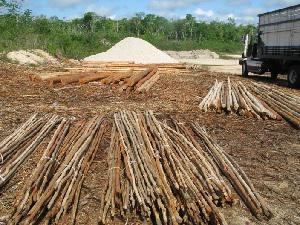José Antonio Sierra Hueslz
The aim is to reduce the vulnerability of tropical forests and people by improving forest management practices of tropical polewood a forest product heavily used in tourism constructions.

Assessing forests product use by beach front resorts.
Globally, the tourism industry is a major consumer of tropical forest products, nonetheless how this demand influences tropical forest management has not been explored in depth. We analyse the links of the tourism market and management practices of a tropical forest product in Quintana Roo (SE Mexico) and develop strategies to sustain conservation values and local livelihoods. Quintana Roo is a tropical state that boasts 91% forest cover and whose coasts are the largest tourism destination in Latin America. Here forests are managed by local communities, many of them ethnically Mayan with a long tradition of subsistence use of forest. In this context we analyse how tourism market, local governance and traditional ecological knowledge interacts shaping tropical forest management practices. We focus on polewood, a remarkably diverse group of small diameter trees (> 30 species, < 35 cm in diameter) that are harvested at a large scale to build beach huts and other rustic constructions utilized by tourism industry.

Polewood hut.
In four communities we are:

Polewood load.
1) monitoring polewood tree harvests,
2) interviewing local stakeholders involved in polewood harvest, commercialization and forest governance,
3) interviewing community members that may be affected or excluded from these activities. Across the state we are conducting
4) extensive interviews with the stakeholders involved in polewood commercialization, construction and regulation,
5) analysis of forest management plans and other technical documents.
The results of this project will be enriched with a parallel meta-analysis of existing ecological indicators (growth, species distribution, dispersal, regeneration) for polewood species. Some of the main aspects that will be analyzed include interaction of polewood management with other activities (e.g. shifting cultivation, and sawtimber harvest); polewood species preferences, diversity and vulnerability, traditional ecological knowledge and local forest governance agreements and their interaction with government regulations; identify management practices that may threat / favor polewood availability.
Overall results will be discussed with regional stakeholders in two workshops to advance in the identification of threats, opportunities to apply locally developed best management practices. Results will be re-assessed after feedback and then shared with communal representatives and organizations, environmental authorities and polewood market actors. This process is joining efforts with an ongoing inter-institutional initiative that seeks the long term sustenance of forest-based livelihoods and conservation values through forest Best Management Practices. Sustaining forest-based livelihoods, particularly in communal management contexts, is critical to conserve forest as the preferred land-use, hence maintaining biodiversity and ecosystem services.